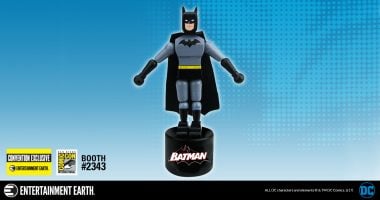THE MENACE IN QUESTION: The zombies of George Romero’s …of the Dead universe.
THE THREAT: Being eaten alive/turned into a zombie yourself.
FIRST APPEARANCE: 1968’s groundbreaking classic Night of the Living Dead.
It may be hard to believe, but the flesh-eating undead have only been around for 48 years – if the concept of the cannibalistic zombie was a person, they wouldn’t even qualify for senior citizen discounts.
These days, they’re ubiquitous thanks to movies, TV series, and comics. But the first to take the zombie and really give it teeth was a Pennsylvanian by the name of George Andrew Romero.
At the time, Romero had no idea that he was revolutionizing an entire horror genre. He just knew that horror sold and was the surest way to make enough moolah to finance his next film project. (Of course, in the wake of Night’s success, Romero was essentially pigeonholed as a horror director/writer, so that plan didn’t exactly pan out…)
Despite its low-budget production values, mostly wooden performances, and depressing ending, Night of the Living Dead proved a smash hit – particularly at the drive-in and midnight-movie circuit – for a number of reasons.
FIRSTLY, the monsters were something audiences had never experienced before; they weren’t sophisticated or foreign like vampires, nor inhumanly-shaped beasts, but familiar neighbors and family warped into something horrifying.
SECONDLY, though filmed in black and white – a choice made for budgetary reasons rather than artistic ones – the gore was shocking for the time; in the infamous scenes Romero dubbed the “Last Supper,” the zombie actors literally chowed down on pig hearts and sheep entrails.
THIRDLY, the lead character was a black man, Ben (Duane Jones), which to this day remains an unfortunate rarity. The most capable and heroic of the characters, Ben doesn’t let the white survivors override his decisions. Romero has long said the polarizing choice in casting wasn’t an intentional one; Jones just happened to be the best actor in the cast. Still, the film wouldn’t be nearly as meaningful if not for the black hero, in large part because…
FOURTHLY, the brutal ending proved unexpectedly timely: Martin Luther King, Jr. was assassinated only days before the film’s release, making it all the more resonant and political. To this day, the nihilistic climax is what guarantees the movie its permanent standing in film history.
Roger Ebert lambasted Night of the Living Dead as a reprehensible picture showcasing an utter destruction of family values with content that could create lasting trauma – a review that only spurred further ticket sales. In its opening weeks, families expecting the usual campy monster fare left showings with sobbing children.
And though it would take Romero another decade to deliver his next zombie flick, the far superior Dawn of the Dead, the mark had been made. A horror revolution had begun.
Slow and uncoordinated Romero’s zombies may be; a little ridiculous and even pathetic. Plenty mock these lumbering undead as easily-avoidable speedbumps. But they perfectly embody the ever-approaching spectre of death. You may be able to outrun it for a while but eventually, everyone trips or has to pause for breath.
Their true power lies in their unrelenting pace and sheer, overwhelming numbers. It doesn’t matter how smart, how healthy, how rich, or how brave you are: the smallest bite will turn you into one of them. In that way, zombies are the greatest equalizer.
Their blank faces and interchangeable, rotting outfits make them the perfect vehicles for social commentary – since Romero first got his hands on them, zombies have represented everything from the Vietnam war (one contemporary reviewer said that if Lyndon B. Johnson had seen Night of the Living Dead, he might never “have permitted the napalming of the Vietnamese”) to rampant consumerism, from biological experimentation to class conflicts.
Special effects wizard Tom Savini (the mentor of Greg Nicotero, the man behind the designs of The Walking Dead) first honed his skills with the …of the Dead series, beginning with Dawn. A former combat photographer, Savini used his personal experiences in Vietnam to shape the zombies in Romero’s first color picture – the bald, burned, plaid-wearing zombie in particular has become iconic.
Dawn of the Dead was one of the first films to use dramatic, realistic blood squibs, which have since been seen thousands of times over in everything from horror to war cinema. The unsettling prog-rock soundtrack provided by Italian group Goblin remains a signature sound of the genre.
In Day of the Dead, Romero threw in yet another twist to the classic zombie story by making one of the central heroes of the story a zombie himself: Bub (Howard Sherman) is a guinea pig in a mad scientist’s experiments, but he shows far more humanity than the soldiers around him. It’s fitting that he gets to take out the central villain, Captain Rhodes (Joseph Pilato), in the film’s climax.
Then in Land of the Dead, another zombie hero makes a stand: Big Daddy (Eugene Clark) is an undead Black Panther who fights for his fellow zombies when the living mercilessly invade their territory and slaughter them.
With the advent of Bub and Big Daddy, audiences became more sympathetic to zombie heroes: Fido (Billy Connolly) of the self-titled horror/comedy was the most loyal best friend a boy could ask for, and the tragic R (Nicholas Hoult) of the book and movie Warm Bodies followed in their staggering footsteps in more recent years.
The impact Romero has had can’t be underestimated in today’s horror landscape. Without his shambolic undead, we never would have had The Walking Dead, Shaun of the Dead, or Resident Evil (originally released in Japan as Biohazard) – basically, the dead would be a helluva lot less frightening.
It’s not often that you can pinpoint the birth of a horror subgenre, when so many are rooted in mythology and fairy tales, but the man-eating zombie has only one Godfather: George A. Romero.
FINAL FACTS:
• The very first movie appearance of a zombie is in 1932’s White Zombie, starring Bela Lugosi – though these silent zombies are traditional Haitian monsters created by “black voodoo,” and fail to take a bite out of anyone.
• Thanks to a simple mistake where the copyright page was left out of the opening credits, Night of the Living Dead immediately entered the public domain, costing Romero and Co. millions of dollars over the decades.
• There are currently six films in the …of the Dead series: Night (1968), Dawn (1978), Day (1985), Land (2005), Diary (2007), and Survival (2009).
• Cameos: Romero is a blink-and-you-miss-it FBI agent in Silence of the Lambs; Simon Pegg and Edgar Wright (the star/writer and writer/director of Shaun of the Dead) are zombies in Romero’s Land of the Dead; make-up maestro Tom Savini is the biker Blades in Dawn and the zombified Blades in Land.
How do you feel about Romero’s zombies and zombies in general? Comment below!
And be sure to check out our next Frightening Fables spotlight next week!










